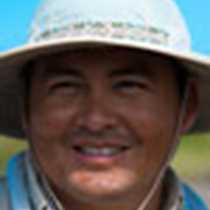Located on the western side of the archipelago and by far the largest island in the Galapagos with a surface area of 4,640 square kilometers (1,792 square miles)—or half of the Galapagos National Park—Isabela offers a unique experience of ancient creatures that symbolize the conservation effort of the national park.
This morning we anchored at Urbina Bay, located at the base of Alcedo Volcano. Our morning expedition began with a wet landing that was fun and challenging for our explorers. Reaching the bay with Zodiacs allowed us to enjoy the green sea turtles that, from time to time, came to the surface to get some air.
Once we disembarked on the black sand beach, hermit-crabs and shells were found on the beach that helped us to interpret and understand more about the natural history of the Galapagos Islands. Deep into the dry forest of holly stick and yellow cordia our dreams came true—the reptiles that gave the name to the islands showed themselves. A dozen giant tortoises delighted our explorers with their extraordinary body size.
The path then led us to one of the most remarkable geological features on Isabela Island. In 1954, approximately a half square kilometer of the marine reef off the coast of Urbina Bay was uplifted suddenly seismic activity by as much as 15 feet (four meters), leaving a huge head of coral exposed.
In the afternoon, our activities began with kayaking along the coastline of Tagus Cove. We saw penguins, cormorants and blue-footed boobies as we enjoyed the peaceful bay. Others wanted to enjoy the underwater realm and went snorkeling. They found several unique species of fish such as harlequin wrasses, bravo clinid, balloonfish, Peruvian grunts and dusky chubs. Sea turtles and Galapagos penguins were also sighted in the snorkeling area.
Late in the afternoon many of our explorers opted to go for a power walk while others went for a Zodiac ride. The end of the day closed with the sun setting behind Fernandina Island.







